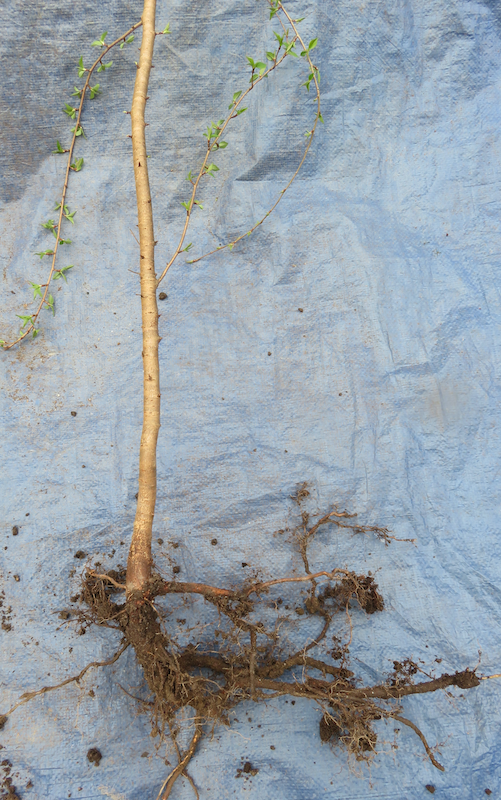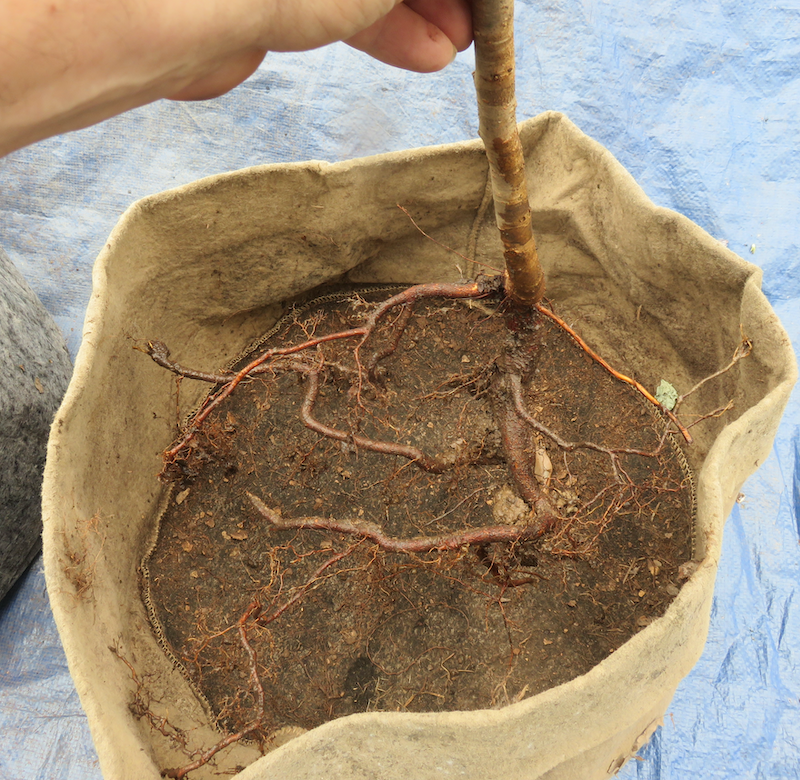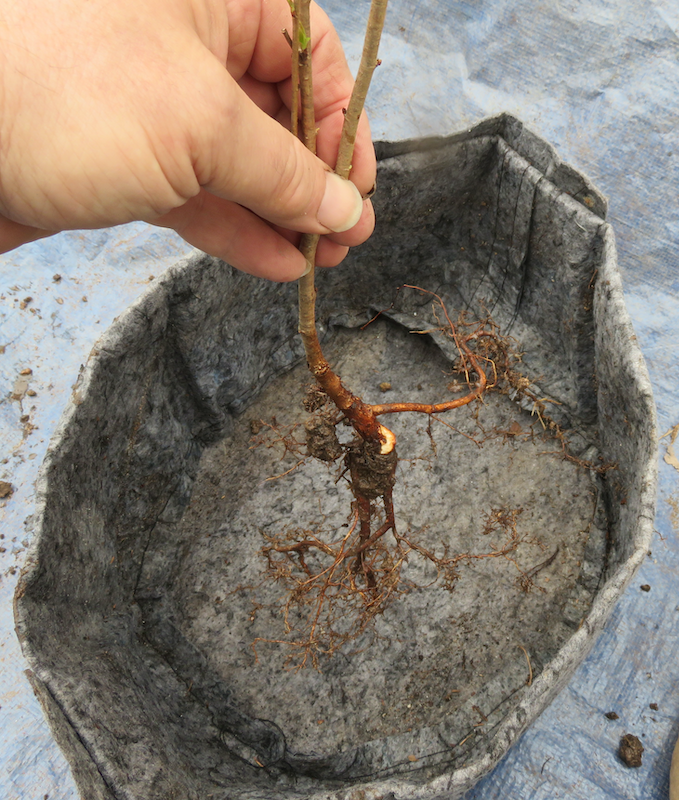Chapter 33 Developing Feeder Roots and Nebari
Commercial nursery growers want to produce trees and shrubs that will grow new roots and establish themselves quickly. Ideally new roots will sprout from all sides but especially the bottom of the root ball within a few weeks. Some of these new roots will continue growing down to become large support roots anchoring the tree in the ground. As a tree continues growing, buttress roots will form around the base that provide further support.
Bonsai growers have different goals, so we have to train root growth differently from the typical nursery.
- We want to train the roots so that the tree has a wide supporting base of buttress roots. This is part of how we create an illusion of greater age and size.
- We want the main roots to radiate laterally like spokes on a wheel, nearly parallel to the surface. There should be 5-20 roots (depending on the tree’s size) that are evenly distributed around the trunk.
- The roots should be visible initially on the surface, then taper and gradually disappear under the surface of the soil.
- The surface roots can twist and turn a little, but should not cross one another.
- Main roots should branch quickly into fine feeder roots under the soil line.
- The bulk of the root mass should be near the surface. Ideally, the vertical thickness of the root mass will be less than the width of the tree at its base.
- There should be no large roots growing vertically into the pot.
The challenge is that bonsai trees are not large and heavy enough to need support from a wide base of buttress roots, so do not form them on their own. Fortunately there are some specific techniques that simultaneously stimulate both radial and buttress root development. Routine root tip pruning stimulates new feeder roots to form.
These are technique that build either the nebari (spreading surface roots), the below-ground feeder roots, or basal trunk taper.
33.1 Landscape Fabric Bags
If a tree has weak or few below-ground roots, I will put it in a landscape fabric bag pot for 2-4 years to build up the feeder root mass. The tree is potted in my normal bonsai soil in spring then watered and fertilized normally. As roots grow they hit the woven fibers and branch rather than turn. Any roots that do pass through the fabric are exposed to air, and die back on their own, which again stimulates fine root branching.
Read the page on Professional Nursery Practices to learn more about these types of pots.
Planting in a bag can be combined with the other techniques below.
1. 
2. 
3. !
4. 
5. 
6. 
Figures 1, 2: Two examples of trees that I would plant in a fabric bag to stimulate feeder root growth. These are the same two saplings that I photographed when showing how to lift trees in spring. Figures 3, 4: Measuring the larger tree in two bag pots. Ideally the current roots should be at least 2/3 of the way to the fabric wall from the center of the bag. The bag in Figure 4 is too small for this tree. Figure 5: The bag that was too small for the larger tree is a good size for the smaller tree. Figure 6: The larger tree, partially potted. Original images by Dan Johnson
33.2 Tourniquet Layering
Tourniquet layering is a technique for creating a ring of roots that emerge from all sides of the trunk in a narrow band. It also increases buttress flare at the base of the trunk.
Many sources call this air layering, but I prefer to call is tourniquet layering for two reasons. First the name better describes what is being done. Second, there is another technique for propagating roots higher up on woody stock that also is called air layering, but is done very differently. Calling this tourniquet layering avoids confusion.
It is done in early spring. A loop of 2 mm aluminum wire is twisted around the trunk, 1/4 to 1/2 inch above the existing roots. The loop should be placed immediately below the point where new roots should emerge from the trunk. The loop is tightened until it just starts to break into the root bark.
The tree is repotted in a deeper than normal container so that the tourniquet is below the soil line. Regular soil is added to just below the tourniquet level. The rest of the container is filled with a mix of 80% soil plus 20% sphagnum peat moss (I use coconut coir.)
One way to simplify this method (or do it outside of spring repotting season) is to apply the tourniquet wire without repotting, on the trunk that is above ground in the current pot. The current pot is extended upward 2-3 inches using a piece of plastic cut from another similarly sized container. The extender is pushed into the pot between the wall and the soil. This is even easier to do if the tree already is in a landscape fabric bag. I simply unfold part of the bag that I folded down previously. For either method, the added space is filled with bonsai soil plus peat moss/coir.
As the tree grows over the next 2-3 years, the constriction in the bark causes nutrients moving down in the phloem to pile up just above the tourniquet, which stimulates root growth. The additional water holding capacity of the top layer of soil will encourage new roots to form and grow horizontally in the upper layer of soil.
Leave the top growth unpruned to encourage vigorous growth of the roots.
Once new roots have formed and expanded, the roots below the tourniquet should be cut back hard to drive growth to the newer roots. Ideally the lower root mass can be sawn off just below the tourniquet.
An alternative to a wire tourniquet is to plant the tree threaded through a hole drilled in a ceramic tile or plate. As the trunk grows the tile constricts the trunk and the trunk above it swells. Eventually roots develop above the tile, and all roots below the tile can be removed. The bottom of the root ball will be almost flat, and require minimal pruning. The plate or tile simply is broken with a hammer to remove it.
33.3 Planting Over a Wood Plate
Some trees already have good basal flare and well placed surface roots, but need more feeder roots growing out laterally instead of vertically. These trees do not need full tourniquet layering. Planting them over a wood plate can help redirect the feeder roots laterally and make the bottom of the root ball nearly flat.
During spring repotting, the bottom of the root ball is bent out laterally and trimmed flat. Then the tree is placed on top of a round piece of 1/4-inch thick pressure treated plywood. This keeps the feeder roots from growing vertically until they reach the edge of the wood circle. Otherwise the tree is planted normally.
I’ve not seen a specific recommendation for the diameter of the wood circle, but based on what I have seen when repotting trees that others started, the wood circle should be around 5-6 times the estimated width of the final basal trunk flare. The circle definitely needs to be at least 1 inch smaller than the narrowest dimension of the training pot. There needs to be ample space for excess water to run past the wood’s edge and drain into the depths of the container.
The wood plate is left in place for 2-3 seasons, until the next time the tree is repotted. Any large roots that have grown over the edge of the plate are trimmed back to the edge of the wooden plate. Then the tree is repotted in a shallower training container to keep the roots from turning down again.
33.4 Splitting and Wedging the Trunk Base
This method is used to increase the basal flare of the trunk. The goal of this technique is to split the portion of the trunk from below ground level to some point above the soil line, bend the segments outward, and keep them separated with a wedge of some kind. This technique requires bare rooting the tree, so should only be done in early spring. It also does not work equally well on all trees. Chinese elms, some junipers, and most ficus respond fairly well to it, and I have read about it being done with maples.
I have never used this method myself, so any description I provide will be second-hand information at best. I suggest searching the web for detailed instructions.
33.5 Thread and Approach Grafting
I described how to use thread and approach grafting to build roots here.